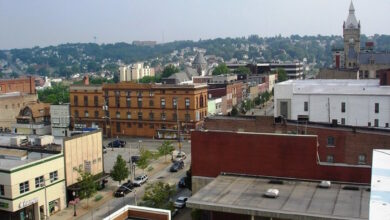Saint Paul: The Capital City of Minnesota
Saint Paul is the second most populous city in Minnesota, after its twin city Minneapolis. Together, they form the core of the Minneapolis–Saint Paul metropolitan area, the third largest in the Midwest. Saint Paul is also the capital of Minnesota and the seat of Ramsey County, the smallest and most densely populated county in the state. Saint Paul has a rich and diverse history, culture, and natural beauty that make it a great place to live, work, and visit. In this article, we will explore some of the facts and attractions of Saint Paul, the city that changed the world.
History and Culture
Saint Paul was founded in 1849 as the capital of the Minnesota Territory, near the confluence of the Mississippi and Minnesota rivers. The city was named after Saint Paul the Apostle, the patron saint of the first church built in the area. Saint Paul grew rapidly as a trading and transportation center, thanks to its strategic location and access to waterways and railroads. The city also became a haven for immigrants, especially from Germany, Ireland, and Scandinavia, who contributed to its cultural diversity and identity.
Saint Paul has many historic landmarks and buildings that reflect its past and present. Some of the most notable ones are:
- The Minnesota State Capitol, a majestic Beaux-Arts building that houses the state legislature, the governor’s office, and the state supreme court. The capitol features a 223-foot dome, a 36-foot marble statue of a Native American warrior, and many murals and sculptures depicting Minnesota’s history and values.
- The Cathedral of Saint Paul, a Roman Catholic cathedral that is the fourth-tallest church in the United States. The cathedral was built in the early 20th century in the Classical Revival style, with a copper-clad dome, a rose window, and a 96-foot baldachin. The cathedral is the mother church of the Archdiocese of Saint Paul and Minneapolis and the seat of the archbishop.
- The James J. Hill House, a Gilded Age mansion that was the home of James J. Hill, the railroad tycoon who built the Great Northern Railway. The house is the largest in Minnesota, with 36,000 square feet, 44 rooms, 13 bathrooms, and 22 fireplaces. The house showcases the lavish lifestyle and achievements of Hill and his family, as well as the social and economic changes of the late 19th and early 20th centuries.
- The Landmark Center, a former federal courthouse and post office that is now a cultural and civic center. The Landmark Center was built in the late 19th century in the Richardsonian Romanesque style, with a clock tower, a turreted roof, and a skylighted atrium. The Landmark Center hosts various events, exhibits, and programs that celebrate the arts, history, and culture of Saint Paul and the region.
Saint Paul is also known for its vibrant and diverse arts and entertainment scene. The city has many theaters, museums, galleries, and festivals that offer a variety of cultural experiences and opportunities. Some of the most popular ones are:
- The Ordway Center for the Performing Arts, a state-of-the-art venue that hosts performances of music, theater, dance, and opera. The Ordway Center is the home of the Minnesota Opera, the Saint Paul Chamber Orchestra, the Schubert Club, and the Ordway Music Theater.
- The Science Museum of Minnesota, a museum that features interactive exhibits, a 10,000-square-foot dinosaur hall, an Omnitheater, and a Mississippi River Gallery. The Science Museum of Minnesota aims to inspire curiosity and learning about science, technology, engineering, and math (STEM) through fun and engaging activities and programs.
- The Minnesota Children’s Museum, a museum that provides playful and hands-on learning experiences for children and families. The Minnesota Children’s Museum has 10 permanent exhibits, such as a four-story climbing adventure, a pretend town, a maker space, and a rooftop garden. The museum also offers special events, camps, and workshops that foster creativity, exploration, and discovery.
- The Saint Paul Winter Carnival, a festival that celebrates winter and the city’s heritage. The Saint Paul Winter Carnival is the oldest and largest winter festival in the United States, dating back to 1886. The festival features various events and attractions, such as ice sculptures, snow sculptures, parades, fireworks, live music, and sports. The festival also has a legend and a royalty, involving a mythical king and queen, a mischievous snowman, and a group of loyal guards.
Nature and Recreation
Saint Paul is not only a city of culture, but also a city of nature. The city has more than 170 parks and open spaces, covering more than 15% of its land area. The city also has more than 26 miles of shoreline along the Mississippi River, the longest of any city on the river. Saint Paul offers many opportunities for outdoor recreation and enjoyment, such as hiking, biking, fishing, boating, golfing, and skiing. Some of the most beautiful and popular parks and trails in the city are:
- The Como Park Zoo and Conservatory, a park that features a zoo, a conservatory, a lake, a golf course, an amusement park, and a Japanese garden. The Como Park Zoo and Conservatory is one of the oldest and most visited attractions in the city, attracting more than 2 million visitors annually. The zoo houses more than 1,000 animals, including polar bears, giraffes, gorillas, and penguins. The conservatory showcases various plants, flowers, and bonsai from around the world, as well as seasonal shows and exhibits.
- The Phalen Regional Park, a park that surrounds Lake Phalen, the largest lake in the city. The Phalen Regional Park offers many amenities and activities, such as a beach, a fishing pier, a boat launch, a golf course, a picnic area, a playground, and a Chinese garden. The park also hosts events and festivals, such as the Dragon Festival, the Hmong Freedom Celebration, and the Phalen Poetry Park.
- The Bruce Vento Regional Trail, a trail that follows the former rail corridor of the Burlington Northern Railroad. The Bruce Vento Regional Trail connects the downtown area of Saint Paul with the suburbs of Maplewood and Vadnais Heights, passing through various neighborhoods, parks, and natural areas. The trail is part of the larger Metro Greenway system, which links the Twin Cities with other regional trails and destinations.
- The Indian Mounds Regional Park, a park that preserves six prehistoric burial mounds of the Dakota people, who inhabited the area for centuries. The Indian Mounds Regional Park also offers scenic views of the downtown skyline and the Mississippi River, as well as a picnic area, a playground, and a trail. The park is listed on the National Register of Historic Places and is a sacred site for the Native American community.
Saint Paul is a city that has something for everyone. Whether you are interested in history, culture, nature, or recreation, you will find it in Saint Paul, the capital city of Minnesota.

